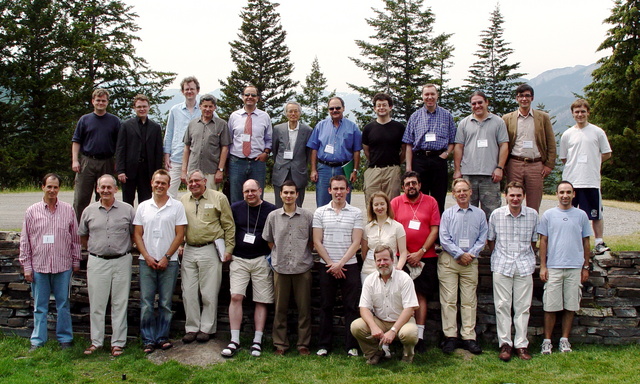Quadrature Domains and Laplacian Growth in Modern Physics (07w5008)
Organizers
Darren Crowdy (Imperial College London)
Bjorn Gustafsson (Royal Institute of Technology, Stockholm)
Mark Mineev-Weinstein (Federal University of Rio Grande do Norte, Brazil)
Mihai Putinar (University of California at Santa Barbara)
Description
Imagine an oil spill in the ocean. Is it possible to locate, from the successive images of the moving boundary, the sources of oil? And vice-versa, knowing the sources, is there possible to predict the shape of the moving boundary between the two fluids? Or, starting with a given skeleton, is there a deterministic approach to model the growth of a crystal, adding one cell after the other, to the skeleton? Conversely, is it possible to model the changing shape of a freezing fluid? The point is that often growing interfaces are highly unstable and unpredictable despite of the deterministic description of the underlying process. The mathematical formulation of these phenomena is known as the Laplacian Growth. Remarkably, despite of the nonlinearity and complexity of these problems, it is often possible to solve them analytically in close form, and to identify geometric quantities which do not change in time. It has been found that exactly the same mathematical structure exists in the equations used in modeling apparently unrelated processes arising in quantum gravity and string theory - theories that are certainly not just of this earth but which purport to describe phenomena way beyond it.
The workshop to take place on July 15-20, 2007 at the Banff Research Station will bring together for the first time at full scale leaders in the field, as well as experts in functional analysis, quantum physics, fluid mechanics, and numerical analysis, all gravitating around the concept of Quadrature Domain and Laplacian Growth. The meeting is expected to mark the birth of a new era in the study of this beautiful and extraordinarily rich intersection between physics and mathematics.
The Banff International Research Station for Mathematical Innovation and Discovery (BIRS) is a collaborative Canada-US-Mexico venture that provides an environment for creative interaction as well as the exchange of ideas, knowledge, and methods within the Mathematical Sciences, with related disciplines within the industry. The research station is located at The Banff Centre in Alberta and is supported by Canada's Natural Science and Engineering Research Council (NSERC), the US National Science Foundation (NSF), Alberta's Advanced Education and Technology, and Mexico's Consejo Nacional de Ciencia y Tecnologa (CONACYT).
The workshop to take place on July 15-20, 2007 at the Banff Research Station will bring together for the first time at full scale leaders in the field, as well as experts in functional analysis, quantum physics, fluid mechanics, and numerical analysis, all gravitating around the concept of Quadrature Domain and Laplacian Growth. The meeting is expected to mark the birth of a new era in the study of this beautiful and extraordinarily rich intersection between physics and mathematics.
The Banff International Research Station for Mathematical Innovation and Discovery (BIRS) is a collaborative Canada-US-Mexico venture that provides an environment for creative interaction as well as the exchange of ideas, knowledge, and methods within the Mathematical Sciences, with related disciplines within the industry. The research station is located at The Banff Centre in Alberta and is supported by Canada's Natural Science and Engineering Research Council (NSERC), the US National Science Foundation (NSF), Alberta's Advanced Education and Technology, and Mexico's Consejo Nacional de Ciencia y Tecnologa (CONACYT).






